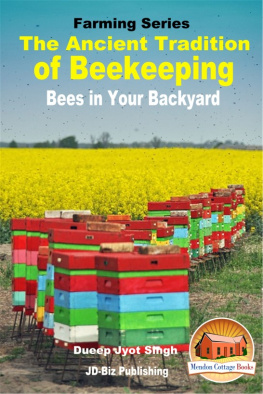No part of this publication may be reproduced in any form or by any means, including scanning, photocopying, or otherwise without prior written permission from JD-Biz Corp Copyright 2016
All Images Licensed by Fotolia and 123RF.
The information is this book is provided for informational purposes only. The information is believed to be accurate as presented based on research by the author.
The author or publisher is not responsible for the use or safety of any procedure or treatment mentioned in this book. The author or publisher is not responsible for errors or omissions that may exist.
Introduction
If you enjoy cooking, or have some interest in herbal remedies, naturally. It is a given that you know all about one of the important ingredients of healing which has been in use for millenniums all over the world in the form of vinegar. Archaeologists have found urns in Egypt, going back to more than 6000 years, with traces of vinegar in them. I would not be surprised if that was just wine which had gone wrong, and somebody decided, all right, we are not going to waste it, we are going to use it for cooking.
The holy Bible refers to vinegar where Ruth was allowed to dip bread in the vinegar Ruth 2:14-by Boaz. He being an ancient and great wise man would know all about the restorative and healing qualities of vinegar.

Once upon a time, one of the greatest mischievous activities which I and my brother loved to indulge in was appreciating the homemade orange wine or any other fruit wine made by my father for home consumption, and then smacking our lips, and saying, Excellent orange vinegar, you have made again dad, where did you go wrong now?
Of course, the wine was excellent, but it would have him hurrying for a glass of his own, and then wondering what he had done to deserve to such philistines who could not appreciate the difference between good wine and good vinegar. And we would always console him that it would do very well when he was cooking chicken or whatever in a casserole.
Seriously speaking, I can recognize drunk vinegar better than drunk wine, today. In our citys French Institute, they have annual wine and cheese sessions, I was always asked to take the first sip of the open bottle to see whether it was fit for consumption. If I looked at the ceiling pensively, and then wondered whether it was wine I was drinking, the bottle would be finished immediately. But the moment I said oh wow, what is this stuff, only those desperate enough to finish the bottles would drink from that particular bottle. It took me 3 years to find out that I was the official vinegar tester!
Naturally, in ancient times, vinegar, which has a large percentage of acetic acid, was not only used for healing and for beauty purposes, but it was also used to give dishes a sour taste.
Let me tell you another amusing story. My French cordon bleu cook friend, Franois, was making up something tasty for his guests, and family one leisurely weekend, and he just happened to say, where is the wine? I busy poking my nose in the kitchen, along with him and getting in his way asked him whether acetic acid would do instead?
I really loved to wind him up while his wife, Dominique, and his children and grandchildren listened to him lose his cool, and splutter and yell Aceetic acid, and you call yourself ze Cuhk.
According to him, any person substituting acetic acid for wine vinegar, was capable of substituting tinned tomatoes or sun-dried tomatoes for homemade tomato sauce, and sandwich spread in salads instead of real homemade mayonnaise. What about the subtle overtones of flavor, what about the glowing rich color, what about the finished dishs rich fragrant aroma, and so on and so forth. Until he would look up and see a whole admiring throng of guests, grinning 3 deep in the sidelines.

In medieval times, they tell about the black plague tormenting Europe where people were so desperate to save themselves that they left their doors open and ran away, not bothering much about their belongings. However, there were 4 crafty thieves, who could not be bothered about any sort of infection because they had made up a mixture told to them by an old witch how did she prevent herself from getting burned at the stake and this is what the recipe says.
Take 1 L of cider vinegar; add 3 teaspoons full of crushed garlic to it, and 2 teaspoons each of dried peppermint, rosemary, and sage. To this add 1 teaspoon each of nutmeg, ground cloves, and cinnamon.
This is the greatest antiseptic you could ever find when you put all the ingredients in a blast vessel and allowed to stand in strong sunlight for 15 days. Strain and bottle, and whenever you are going in an infectious area, do what the 4 thieves did, cover your face and your hands with clothes dipped in this mixture, and you are not going to get infected. Also, cover your feet, if you are robbing the dead on the streets.
Well, they supposedly plea bargained for freedom, by giving their judges this recipe, but knowing about those ruthless times, I am hundred percent sure that they were dispatched yea verily, foresooth and right speedily by the ruthless judges so that they could not go around telling everybody else about this cure.
Vin aigre is the French word for sour wine, hence where the word vinegar comes from. This term is also used when referring to alcohol-based liquids that are sour since they are made with malt, cider, or rice wine.
Making of Vinegar

Just like wine, good vinegar is also going to be made in casks.
This souring is, of course, a natural process that happens when liquids with less than 18% alcohol come in contact with the air.
A reaction occurs when the bacteria in the air comes in contact with the alcohol, it makes a thick, moldy looking skin the covers the surface of the liquid. This is known as the mother liquid, which is basically a layer of yeast, which makes a natural acid out of the alcohol. The acid is what is going to give the vinegar its distinct flavor.
Although this reaction is going to occur naturally, it's not always consistent, because there are a number of factors which are going to either delay or promote this fermentation process. To produce high quality vinegars the speed and the temperature of this process has to be monitored, regulated, and controlled. In ancient times, people were experienced enough to know exactly when the vinegars could be taken out from the casks, but today winemakers and vinegar makers have a completely scientifically controlled process used in making wines.















